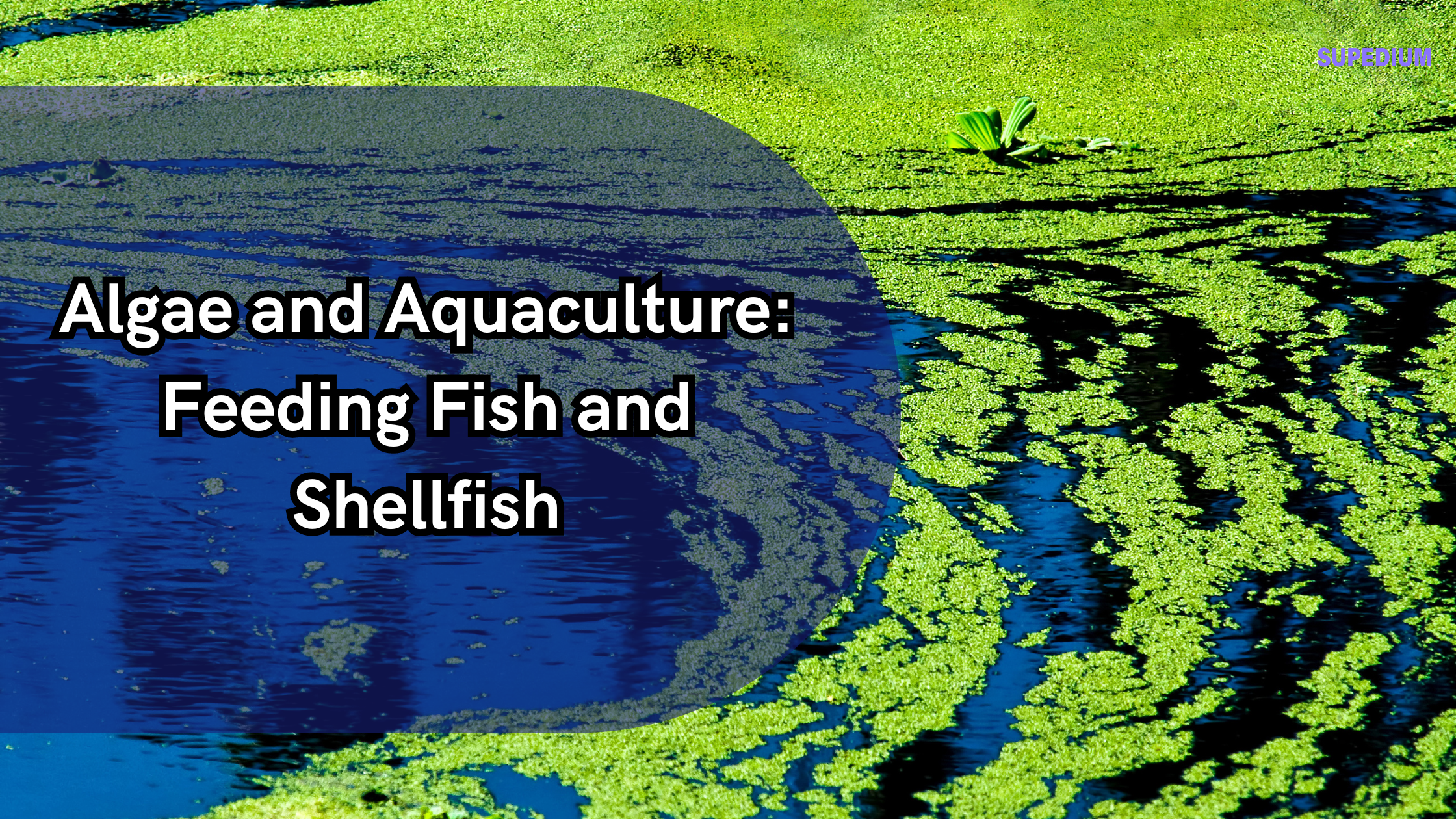Table of Contents
- 1 Introduction
- 2 Types of Algae Used in Aquaculture
- 3 Nutritional Benefits of Algae-Based Feeds
- 4 Applications of Algae in Fish and Shellfish Feeding
- 5 Production and Sustainability Aspects
- 6 Challenges and Future Directions
- 7 Quality Control and Consistency
- 8 Research and Development Needs
- 9 Regulatory and Industry Standards
- 10 Case Studies
- 11 Conclusion
![]()
Introduction
Aquaculture, the farming of fish and shellfish, is a crucial component of global food security, providing a significant portion of the world’s seafood supply. In recent years, there has been increasing interest in utilizing algae as a feed source in aquaculture due to their rich nutritional profile and potential environmental benefits. This article delves into the role of algae in feeding fish and shellfish, exploring the types of algae used, their nutritional benefits, applications in different stages of aquaculture, production and sustainability aspects, challenges, and future directions.
Types of Algae Used in Aquaculture
Algae used in aquaculture can be broadly categorized into microalgae and macroalgae, each offering unique benefits to aquatic species.
Microalgae
- Chlorella: This green microalga is known for its high protein content, including essential amino acids, and its rich vitamin and mineral profile. It is beneficial for fish and shellfish as it promotes growth and enhances immune responses.
- Spirulina: Another valuable microalga, Spirulina, is rich in proteins, vitamins (including B12), and minerals. Its high carotenoid content contributes to better coloration in fish and provides significant health benefits.
- Diatoms: These are a type of algae used primarily in shellfish feeds. They are known for their high silica content, which supports the development of shell strength in bivalves like oysters and clams.
- Dunaliella: Notable for its high carotenoid content, particularly beta-carotene, Dunaliella enhances pigmentation in fish and provides antioxidant benefits, promoting overall health.
Macroalgae
- Kelp (Laminaria): Kelp is rich in iodine, vitamins, and minerals. Its high fiber content helps in digestion and overall health of fish and shellfish. It is commonly used in both direct feed and as a supplementary ingredient.
- Red Algae (e.g., Porphyra): Red algae are valued for their high protein content and essential fatty acids. They are particularly beneficial for enhancing the nutritional quality of feed.
- Sea Lettuce (Ulva): Sea lettuce is known for its high fiber content and essential nutrients. It is used to improve the growth rates and health of various aquaculture species.
Nutritional Benefits of Algae-Based Feeds
Algae-based feeds offer several nutritional advantages over traditional feed sources, contributing to the overall health and growth of aquaculture species.
Proteins and Amino Acids
Algae provide high-quality proteins and essential amino acids comparable to, and in some cases exceeding, traditional feed ingredients such as fishmeal. This high protein content is crucial for optimal growth rates and feed conversion ratios in fish and shellfish.
Vitamins and Minerals
Algae are a rich source of essential vitamins such as B12, A, and D, and important minerals like calcium and iodine. These nutrients are vital for metabolic processes, bone development, and overall health of aquatic organisms.
Omega-3 Fatty Acids
Many algae species are excellent sources of omega-3 fatty acids, which are crucial for maintaining heart health and improving the flesh quality of fish. Including omega-3-rich algae in feeds enhances the nutritional value of seafood products.
Antioxidants and Phytochemicals
Algae are rich in antioxidants and phytochemicals that support immune system function and disease resistance. These compounds help protect fish and shellfish from oxidative stress and improve their overall health.
Applications of Algae in Fish and Shellfish Feeding
The application of algae in aquaculture varies depending on the growth stage of the species being cultivated.
Larval and Juvenile Stages
In the larval and juvenile stages, algae play a crucial role in providing essential nutrients that support early development. Methods of incorporating algae into larval diets include direct addition to water or blending with other feed components.
Grow-out Stages
During the grow-out stages, algae can be integrated into feeds to enhance growth performance and feed efficiency. Techniques for including algae in grow-out feeds include blending with other ingredients or using algae-based pellets.
Shellfish Cultivation
For shellfish, which are filter feeders, algae serve as the primary feed source. Algae cultivation methods include open pond systems and photobioreactors, with algae being delivered directly to shellfish in aquaculture systems.
Production and Sustainability Aspects
The production of algae for aquaculture involves several methods and has implications for sustainability and economics.
Cultivation of Algae
Algae can be cultivated in various systems, including open ponds and closed photobioreactors. Each method has its challenges, such as maintaining optimal growth conditions and preventing contamination. Advances in cultivation techniques continue to improve the efficiency and scalability of algae production.
Environmental Impact
Compared to traditional feed sources, algae production generally has a lower environmental impact. Algae cultivation can reduce reliance on fishmeal and other unsustainable ingredients, contributing to more sustainable aquaculture practices.
Economic Considerations
While the cost of algae production can be higher than traditional feeds, the potential benefits, including improved health and growth of aquatic species and reduced environmental impact, can justify the investment. The economic feasibility of algae-based feeds is an area of ongoing research and development.
Challenges and Future Directions
Several challenges and future directions are essential to consider in the context of algae-based feeds.
Quality Control and Consistency
Ensuring consistent quality in algae-based feeds is crucial. Variability in nutritional content can affect the effectiveness of feeds. Standardization and quality control measures are needed to address this challenge.
Research and Development Needs
Further research is needed to advance algae cultivation techniques, optimize feed formulations, and explore new algae species with beneficial properties. Innovations in these areas will drive the future of algae-based feeds in aquaculture.
Regulatory and Industry Standards
Current regulations on algae-based feeds vary by region and industry. Future developments in policy and industry standards will play a role in shaping the use of algae in aquaculture and ensuring its safe and effective application.
Case Studies
Several case studies illustrate the successful implementation of algae-based feeds in aquaculture.
Successful Implementation in Fish Farming
Examples of fish farms using algae-based feeds include those utilizing Spirulina and Chlorella. These farms have reported improved growth rates, enhanced health, and better feed conversion ratios.
Shellfish Aquaculture
In shellfish farms, the use of diatoms and other algae has resulted in stronger shells and improved growth rates. The direct delivery of algae to filter-feeding shellfish has proven effective in maintaining high productivity.
Conclusion
Algae play a vital role in modern aquaculture, offering numerous benefits as feed sources for fish and shellfish. Their rich nutritional profile, combined with their potential for reducing environmental impact, makes them a valuable component of sustainable aquaculture practices. As research and technology advance, algae-based feeds are expected to become increasingly integral to aquaculture, contributing to the health and productivity of aquatic species while supporting more sustainable seafood production.
Share This





Be the first to comment